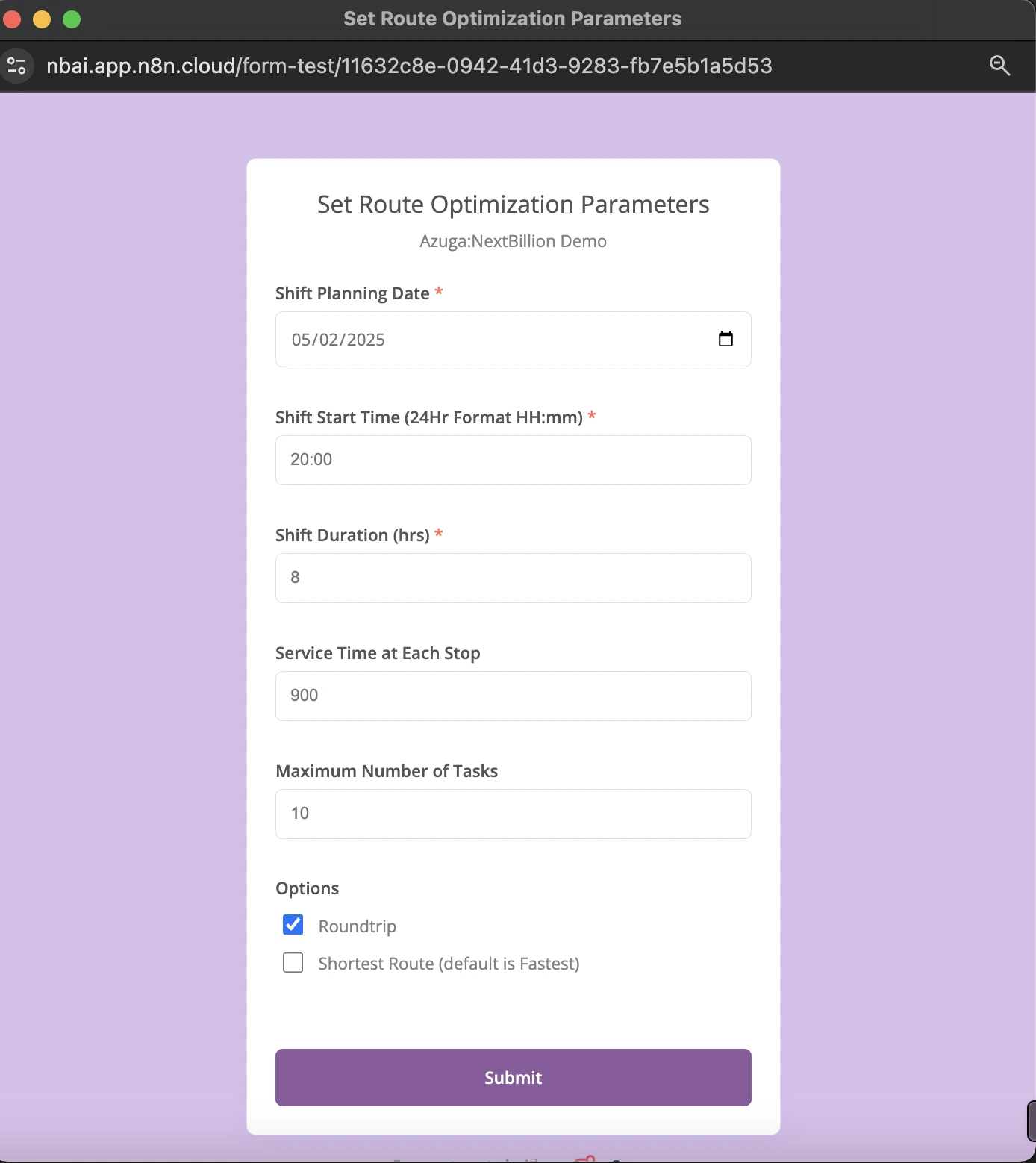Azuga Telematics Integration with Route Optimization API
Overview
This document outlines how to integrate Azuga, a telematics and fleet management platform, with NextBillion.ai’s Route Optimization API. The integration leverages n8n as the orchestration layer to automate data flow and optimize vehicle routes using real-time data from Azuga.
Prerequisites
Before starting the integration, ensure you have the following:
- Azuga API Credentials: You will need valid Azuga credentials, including a Client ID Client Secret and an Access Token. Access your Azuga account to retrieve your credentials.
- Your NextBillion.ai API Key. If you don't have one, contact NextBillion.ai and get it now.
- An n8n account to create and execute workflows.
Integration Steps
The integration and data flow between Azuga and NextBillion.ai is managed using an n8n workflow that performs the following:
- Retrieves vehicle and job data from Azuga
- Modify the data formats and map it to the right properties of NextBillion.ai Route Optimization.
- Submit a request to NextBillion.ai’s Route Optimization API
- Polls for job completion and retrieves the Route Optimization solution
- Stores results in a Google Sheet or downstream system
Step 1: Define Input Parameters
To start with, set up input nodes in n8n to define parameters such as region, time window, and vehicle type.

Define parameters for the n8n workflow
Step 2: Authenticate with Azuga
Use Azuga's OAuth or token-based authentication:
Step 3: Fetch required data from Azuga
Pull the latest location of desired vehicles from Azuga using the following endpoint:
Refer to the Azuga documentation for detailed information on features and supported properties for obtaining the most recent vehicle locations.
Users can also pull the geofence data that they maintain using Azuga with the help of following endpoint:
Refer to the Azuga documentation for detailed information on features and supported properties for obtaining desired geofences.
Step 4: Modify, Merge and Map Data Fields
Combine job and vehicle data into NextBillion-compatible format including:
jobsvehiclesoptionslocations
Refer to the Route Optimization API documentation to learn more about the expected data formats for creating NextBillion.ai Route Optimization jobs.
Step 5: Submit a request to NextBillion.ai Route Optimization
Use the n8n workflow to submit a request to NextBillion.ai’s Route Optimization API and create optimization jobs based on certain parameters.
Use the response from the POST endpoint above to retrieve the unique ID of the job submitted.
Step 6: Retrieved Optimized Route Result
Use a loop or timed delay in n8n to check for job status for the unique ID obtained in the previous step:
Step 7: Store or Visualize Results
Store the optimized results into a Google Sheet or render them via the Route Planner Tool in NextBillion.ai Cloud Console.
Planned routes will be pushed into the Azuga Fleet Management platform and Driver Applications once support is available in the Azuga platform.
Benefits
- Real-time Optimization using current Azuga telematics data
- Low-Code Automation using n8n
- Customizable Logic for filtering, mapping, and scheduling
Resources
- NextBillion.ai Route Optimization API Docs
- Azuga Developer Documentation
- n8n Workflow Hub
For questions or implementation support, please contact your solutions engineering team or [email protected].